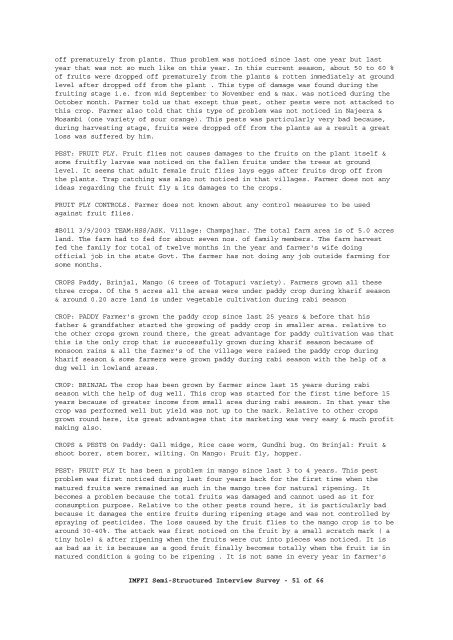“Key Informant Survey” of Production, Value, Losses and ... - DfID
“Key Informant Survey” of Production, Value, Losses and ... - DfID
“Key Informant Survey” of Production, Value, Losses and ... - DfID
Create successful ePaper yourself
Turn your PDF publications into a flip-book with our unique Google optimized e-Paper software.
<strong>of</strong>f prematurely from plants. Thus problem was noticed since last one year but last<br />
year that was not so much like on this year. In this current season, about 50 to 60 %<br />
<strong>of</strong> fruits were dropped <strong>of</strong>f prematurely from the plants & rotten immediately at ground<br />
level after dropped <strong>of</strong>f from the plant . This type <strong>of</strong> damage was found during the<br />
fruiting stage i.e. from mid September to November end & max. was noticed during the<br />
October month. Farmer told us that except thus pest, other pests were not attacked to<br />
this crop. Farmer also told that this type <strong>of</strong> problem was not noticed in Najeera &<br />
Mosambi (one variety <strong>of</strong> sour orange). This pests was particularly very bad because,<br />
during harvesting stage, fruits were dropped <strong>of</strong>f from the plants as a result a great<br />
loss was suffered by him.<br />
PEST: FRUIT FLY. Fruit flies not causes damages to the fruits on the plant itself &<br />
some fruitfly larvae was noticed on the fallen fruits under the trees at ground<br />
level. It seems that adult female fruit flies lays eggs after fruits drop <strong>of</strong>f from<br />
the plants. Trap catching was also not noticed in that villages. Farmer does not any<br />
ideas regarding the fruit fly & its damages to the crops.<br />
FRUIT FLY CONTROLS. Farmer does not known about any control measures to be used<br />
against fruit flies.<br />
#B011 3/9/2003 TEAM:HSS/ASK. Village: Champajhar. The total farm area is <strong>of</strong> 5.0 acres<br />
l<strong>and</strong>. The farm had to fed for about seven nos. <strong>of</strong> family members. The farm harvest<br />
fed the family for total <strong>of</strong> twelve months in the year <strong>and</strong> farmer's wife doing<br />
<strong>of</strong>ficial job in the state Govt. The farmer has not doing any job outside farming for<br />
some months.<br />
CROPS Paddy, Brinjal, Mango (6 trees <strong>of</strong> Totapuri variety). Farmers grown all these<br />
three crops. Of the 5 acres all the areas were under paddy crop during kharif season<br />
& around 0.20 acre l<strong>and</strong> is under vegetable cultivation during rabi season<br />
CROP: PADDY Farmer's grown the paddy crop since last 25 years & before that his<br />
father & gr<strong>and</strong>father started the growing <strong>of</strong> paddy crop in smaller area. relative to<br />
the other crops grown round there, the great advantage for paddy cultivation was that<br />
this is the only crop that is successfully grown during kharif season because <strong>of</strong><br />
monsoon rains & all the farmer's <strong>of</strong> the village were raised the paddy crop during<br />
kharif season & some farmers were grown paddy during rabi season with the help <strong>of</strong> a<br />
dug well in lowl<strong>and</strong> areas.<br />
CROP: BRINJAL The crop has been grown by farmer since last 15 years during rabi<br />
season with the help <strong>of</strong> dug well. This crop was started for the first time before 15<br />
years because <strong>of</strong> greater income from small area during rabi season. In that year the<br />
crop was performed well but yield was not up to the mark. Relative to other crops<br />
grown round here, its great advantages that its marketing was very easy & much pr<strong>of</strong>it<br />
making also.<br />
CROPS & PESTS On Paddy: Gall midge, Rice case worm, Gundhi bug. On Brinjal: Fruit &<br />
shoot borer, stem borer, wilting. On Mango: Fruit fly, hopper.<br />
PEST: FRUIT FLY It has been a problem in mango since last 3 to 4 years. This pest<br />
problem was first noticed during last four years back for the first time when the<br />
matured fruits were remained as such in the mango tree for natural ripening. It<br />
becomes a problem because the total fruits was damaged <strong>and</strong> cannot used as it for<br />
consumption purpose. Relative to the other pests round here, it is particularly bad<br />
because it damages the entire fruits during ripening stage <strong>and</strong> was not controlled by<br />
spraying <strong>of</strong> pesticides. The loss caused by the fruit flies to the mango crop is to be<br />
around 30-40%. The attack was first noticed on the fruit by a small scratch mark ( a<br />
tiny hole) & after ripening when the fruits were cut into pieces was noticed. It is<br />
as bad as it is because as a good fruit finally becomes totally when the fruit is in<br />
matured condition & going to be ripening . It is not same in every year in farmer's<br />
IMFFI Semi-Structured Interview Survey - 51 <strong>of</strong> 66

















